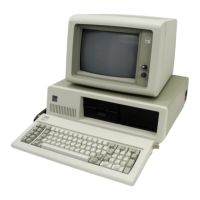-I/O
cn
CK (I)
-I/O
Channel Check: This line provides the microprocessor with
parity (error) information
on
memory
or
devices in the
I/O
channel. When this signal
is
active low, a parity error
is
indicated.
I/O
cn
RDY (I)
I/O
Channel Ready: This line, normally high (ready),
is
pulled
low (not ready)
by
a memory
or
I/O
device to lengthen
I/O
or
memory cycles.
It
allows slower devices to attach to the
I/O
channel with a minimum of difficulty. Any slow device using this
line should drive it low immediately upon detecting a valid address
and a
Read
or
Write command. This line should never
be
held
low longer
than
10 clock cycles. Machine cycles
(I/O
or
memory) are extended by an integral number of clock cycles
(210ns).
-lOR
(0)
-I/O
Read
Command: This command line instructs
an
I/O
device
to
drive its data onto the data bus.
It
may
be
driven by the
microprocessor
or
the
DMA
controller. This signal
is
active low.
-lOW
(0)
-I/O
Write Command: This command line instructs an
I/O
device
to
read the data
on
the data bus.
It
may be driven by the
microprocessor
or
the
DMA
controller. This signal
is
active low.
IRQ2-IRQ7
(I)
Interrupt Request 2 to 7: These lines are used to signal the
microprocessor
that
an
I/O
device requires attention. They are
prioritized with
IRQ2
as the highest priority and IRQ7 as the
lowest.
An
interrupt request
is
generated by raising
an
IRQ
line
(low to high) and holding it high until it
is
acknowledged by the
microprocessor (interrupt service routine).
1-22 System Board

